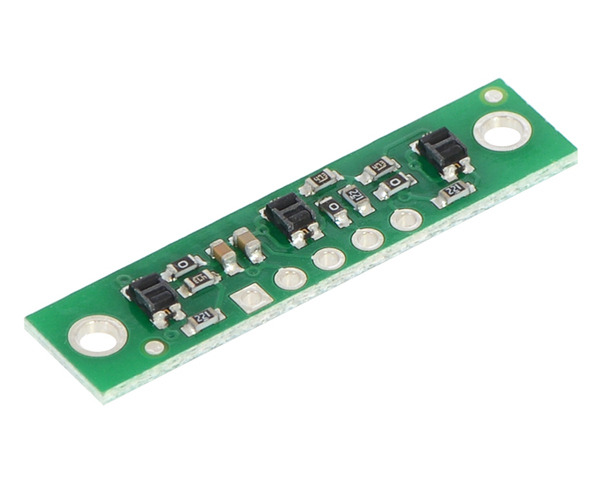

This is a merged information page for Item #2456.
View normal product page.
Pololu item #:
2456
Brand:
Pololu
Status:
Active and Preferred

This compact module packs three IR LED/phototransistor pairs onto a 1.25″ × 0.3″ board. The sensors are mounted on a 0.375″ pitch, making this array a great minimal sensing solution for a line-following robot. Each sensor provides a separate analog voltage output.
 Compare all products in Older QTR Sensors.
Compare all products in Older QTR Sensors.
 |
QTR-3A reflectance sensor array. |
|---|
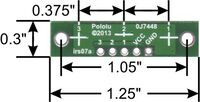 |
QTR-3A or QTR-3RC reflectance sensor array, bottom view with dimensions. |
|---|
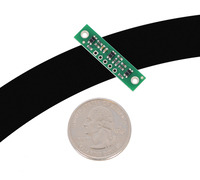 |
QTR-3A or QTR-3RC reflectance sensor array on a 3/4" line with a quarter for size reference. |
|---|
 |
QTR-3A or QTR-3RC reflectance sensor array with included header pins. |
|---|
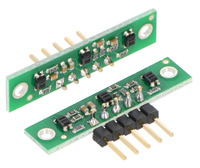 |
QTR-3A and QTR-3RC reflectance sensor arrays soldered in different orientations. |
|---|
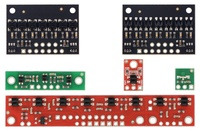 |
QTR sensor size comparison. Top row: QTRX-HD-07, QTR-HD-07; middle row: QTR-3, QTR-1, QTR-L-1; bottom row: QTR-8. |
|---|
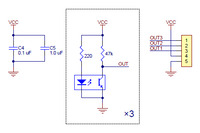 |
Schematic diagram for the QTR-3A reflectance sensor array. |
|---|
The QTR-3A reflectance sensor array requires analog inputs to take readings. The similar QTR-3RC reflectance sensor array is available with digital I/O-compatible outputs.
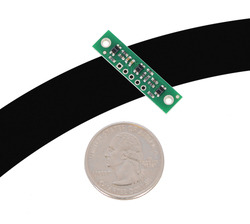 |
The QTR-3A reflectance sensor array is intended as a line sensor, but it can be used as a general-purpose proximity or reflectance sensor. The module is a convenient carrier for three IR emitter and receiver (phototransistor) pairs. With sensors spaced at intervals of 0.375″ (9.525 mm) along of the board’s longer axis, this array works well as a minimal detector for line-following robots, as line-following courses are commonly made using 3/4″ (19 mm) black electrical tape. The middle sensor is slightly offset along the short axis of the board.
Each phototransistor is connected to a pull-up resistor to form a voltage divider that produces an analog voltage output between 0 V and VCC (which is typically 5 V) as a function of the reflected IR. Lower output voltage is an indication of greater reflection.
The LED current-limiting resistors are set to deliver approximately 17 mA to the LEDs when VCC is 5 V, making the total board consumption just over 50 mA. The schematic diagram of the module is shown below:
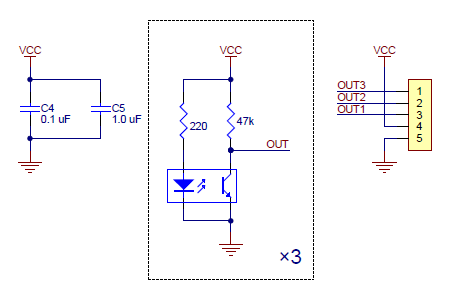 |
This schematic is also available as a downloadable pdf (115k pdf).
For an alternative array with eight sensors and the ability to turn off the IR LEDs to limit power consumption, consider our QTR-8A reflectance sensor array. For individual reflectance sensors, consider our QTR-1A and QTR-L-1A.
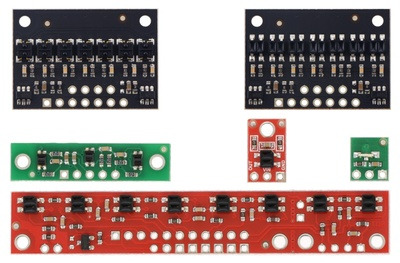 |
QTR sensor size comparison. Top row: QTRX-HD-07, QTR-HD-07; middle row: QTR-3, QTR-1, QTR-L-1; bottom row: QTR-8. |
|---|
 |
There are several ways you can interface with the QTR-3A outputs:
This last method will work if you are able to get high reflectance from your white surface as depicted in the left image, but will probably fail if you have a lower-reflectance signal profile like the one on the right. (Please note that these images show the output of a QTR-1A, which uses a sensor with slightly different characteristics than the ones on the QTR-3A.)
|
|
Our Pololu AVR library provides functions that make it easy to use these sensors with our Orangutan robot controllers; please see the QTR Reflectance Sensors section of our library command reference for more information. We also have a Arduino library for these sensors.
This module has two mounting holes intended for #2 screws (not included); if the mounting holes are not needed, the ends of the PCB can be ground off to make the unit even smaller (less than 1″ wide). The reflectance sensor array ships with a 1×5 straight male header strip and a1×5 right-angle male header strip as shown below. You can also solder wires, such as ribbon cable, directly to the pads for the smallest installation.
|
|
| Size: | 1.25″ × 0.3″1 |
|---|---|
| Weight: | 0.6 g2 |
| Supply current: | 50 mA |
|---|
| PCB dev codes: | irs07a |
|---|---|
| Other PCB markings: | 0J7448 |
Information about using the Pololu QTR reflectance sensors, including differences between A-type and RC-type sensors and sample oscilloscope screen captures of sensor outputs.
Information about installing and using the C/C++ libraries provided for use with Pololu products.
A reference to commands provided in the Pololu C/C++ and Arduino libraries for the AVR.
Step-by-step instructions for building your own line-following courses.
Printable schematic diagram for the QTR-3A reflectance sensor array.
Datasheet for the sensor used on the QTR-3RC and QTR-3A Reflectance Sensor Arrays, the Zumo 32U4 robot front sensor array, and the Optical Encoders for micro metal gearmotors.
Un guide utiliser et exploiter un senseur QTR (détecteur de ligne) (version 0.1). Note: This French translation of our QTR sensor documentation was made by our distributor MCHobby.
Matthew Phillipps ported our Arduino Library for the Pololu QTR Reflectance Sensors to the mbed platform. The Arduino library is designed to work with Pololu QTR reflectance sensors, so the mbed library should too, but Matthew points out he only tested it with the analog sensors. This library was not written and is not maintained by Pololu.
This library for Arduino makes it easy to interface with Pololu QTR Reflectance Sensors.
No FAQs available.
Abe Howell posted to our forum about a Kickstarter campaign for a robot he calls Apeiros. It is an open-source robot he designed as a teaching tool...
This post is about my first-place entry in the 2014 LVBots Dead Reckoning Competition, a 150 mm round robot named paul-dead-reckoning2.88ec5df. I...